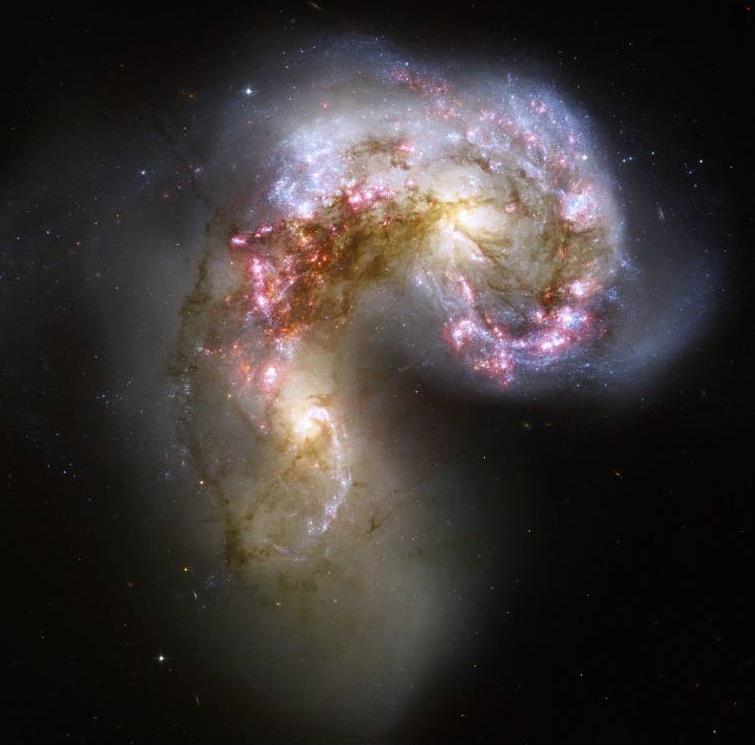
Antennae Galaxy
The Antennae galaxies, NGC 4038 and NGC 4039) are a pair of spiral galaxies that started to interact and merge a few hundred million years ago. They are the nearest and, perhaps, youngest examples of a pair of colliding galaxies. During the course of the collision, billions of stars will be formed. The brightest and most compact of these star birth regions are called super star clusters. Nearly half of the faint objects in the Antennae image are young clusters containing tens of thousands of stars. The orange blobs to the left and right of image center are the two cores of the original galaxies and consist mainly of old stars criss-crossed by filaments of dust, which appears brown in the image. The two galaxies are dotted with brilliant blue star-forming regions surrounded by glowing hydrogen gas, appearing in the image in pink.
By age dating the clusters in the image, astronomers find that only about 10 percent of the newly formed super star clusters in the Antennae will survive beyond the first 10 million years. The vast majority of the super star clusters formed during this interaction will disperse, with the individual stars becoming part of the smooth background of the galaxy. It is however believed that about a hundred of the most massive clusters will survive to form regular globular clusters, similar to the globular clusters found in our own Milky Way galaxy. They are approximately 14 Mpc (about 45 million light-years) away.
The Antennae galaxies take their name from the long antenna-like "arms" extending far out from the nuclei of the two galaxies, as shown in the other image of the two galaxies.
Credit: NASA, ESA, and the Hubble Heritage Team (STScl/AURA) -
ESA/Hubble Collaboration -
B. Whitmore (space Telescope Science Institute)
By age dating the clusters in the image, astronomers find that only about 10 percent of the newly formed super star clusters in the Antennae will survive beyond the first 10 million years. The vast majority of the super star clusters formed during this interaction will disperse, with the individual stars becoming part of the smooth background of the galaxy. It is however believed that about a hundred of the most massive clusters will survive to form regular globular clusters, similar to the globular clusters found in our own Milky Way galaxy. They are approximately 14 Mpc (about 45 million light-years) away.
The Antennae galaxies take their name from the long antenna-like "arms" extending far out from the nuclei of the two galaxies, as shown in the other image of the two galaxies.
Credit: NASA, ESA, and the Hubble Heritage Team (STScl/AURA) -
ESA/Hubble Collaboration -
B. Whitmore (space Telescope Science Institute)